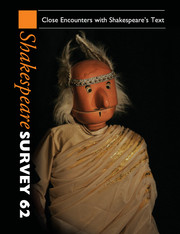Book contents
- Frontmatter
- Shakespeare, text and paratext
- The popularity of Shakespeare in print
- The continuing importance of new Bibliographical method
- ‘Honour the real thing’: Shakespeare, Trauma and Titus Andronicus in South Africa
- ‘O, these encounterers’: on Shakespeare’s meetings and partings
- A play of modals: Grammar and potential action in early Shakespeare
- Merry, marry, Mary: Shakespearian wordplay and Twelfth Night
- A subtle point: Sleeves, tents and ‘Ariachne’s broken woof’ (again)
- The look of Othello
- Red button Shakespeare
- ‘Mark you / his absolute shall?’: Multitudinous tongues and contested words in Coriolanus
- Chagall’s Tempest: An autobiographical reading
- Reading illustrated editions: Methodology and the limits of interpretation
- Close encounters with Anne Brontë's Shakespeare
- Shakespeare and the magic lantern
- Shakespeare and the coconuts: close encounters in post-apartheid South Africa
- The Schrödinger effect: Reading and misreading performance
- Behind the scenes
- Inner monologues: Realist acting and/as Shakespearian performance text
- More japanized, casual and transgender shakespeares
- Translation futures: Shakespearians and the foreign text
- After translation
- ‘The single and peculiar life’: Hamlet’s heart and the early modern subject
- Mapping King Lear
- ‘Last on the stage’: The place of Shakespeare in Charles Darwin’s ethology
- Sense/memory/sense-memory: Reading narratives of Shakespearian rehearsals
- Shakespeare performances in England (and Wales), 2008
- Professional Shakespeare productions in the British Isles, January–December 2007
- The Year's Contributions to Shakespearian Study 1 Critical Studies
- 2 Shakespeare in performance
- 3a Editions and textual studies
- 3b Editions and textual studies
- Index to Volume 62
Behind the scenes
Published online by Cambridge University Press: 28 November 2009
- Frontmatter
- Shakespeare, text and paratext
- The popularity of Shakespeare in print
- The continuing importance of new Bibliographical method
- ‘Honour the real thing’: Shakespeare, Trauma and Titus Andronicus in South Africa
- ‘O, these encounterers’: on Shakespeare’s meetings and partings
- A play of modals: Grammar and potential action in early Shakespeare
- Merry, marry, Mary: Shakespearian wordplay and Twelfth Night
- A subtle point: Sleeves, tents and ‘Ariachne’s broken woof’ (again)
- The look of Othello
- Red button Shakespeare
- ‘Mark you / his absolute shall?’: Multitudinous tongues and contested words in Coriolanus
- Chagall’s Tempest: An autobiographical reading
- Reading illustrated editions: Methodology and the limits of interpretation
- Close encounters with Anne Brontë's Shakespeare
- Shakespeare and the magic lantern
- Shakespeare and the coconuts: close encounters in post-apartheid South Africa
- The Schrödinger effect: Reading and misreading performance
- Behind the scenes
- Inner monologues: Realist acting and/as Shakespearian performance text
- More japanized, casual and transgender shakespeares
- Translation futures: Shakespearians and the foreign text
- After translation
- ‘The single and peculiar life’: Hamlet’s heart and the early modern subject
- Mapping King Lear
- ‘Last on the stage’: The place of Shakespeare in Charles Darwin’s ethology
- Sense/memory/sense-memory: Reading narratives of Shakespearian rehearsals
- Shakespeare performances in England (and Wales), 2008
- Professional Shakespeare productions in the British Isles, January–December 2007
- The Year's Contributions to Shakespearian Study 1 Critical Studies
- 2 Shakespeare in performance
- 3a Editions and textual studies
- 3b Editions and textual studies
- Index to Volume 62
Summary
The Royal Shakespeare Theatre is currently undergoing a radical transformation. Described in company publicity as 'one of the world's most iconic theatrical sites', the theatre closed in 2007 for refurbishment, to reopen in 2010 as, it is hoped, 'the best theatre for Shakespeare in the world'. The 1930s cinema-style auditorium reviled by generations of its users has been demolished, to be replaced by what is described by the Royal Shakespeare Company's Artistic Director Michael Boyd as 'a theatre which celebrates interaction. . . a bold, thrust-stage, one-room auditorium - a modern take on the theatres of Shakespeare's day'. One of the distinctive elements of this latest attempt to reshape the conditions of Shakespearean performance is indicated by Boyd's description of the company's temporary replacement and prototype for the new theatre, the Courtyard, as 'a meeting place between audience and actors . . . where we can make some kind of fragile consensus together'. Summoning an egalitarian and inclusive ethos long associated with thrust stages, as well as current discourses of conflict resolution, the remark suggests that getting physically closer to Shakespeare in Stratford confers benefits beyond the theatrical: the Courtyard stage, and its permanent successor, are envisaged as not only neo-Elizabethan performance spaces but also as forums for creative dialogue, collective problem-solving and democratic participation. This is not new, in that the open stage has been subject to such a quasi-political inflection throughout the entire history of theatrical modernism; what is relatively unusual about Boyd's concern for consensus-building is that it emerges from a specific, and indeed acutely sensitive, local context.
- Type
- Chapter
- Information
- Shakespeare Survey , pp. 236 - 248Publisher: Cambridge University PressPrint publication year: 2009
- 1
- Cited by

